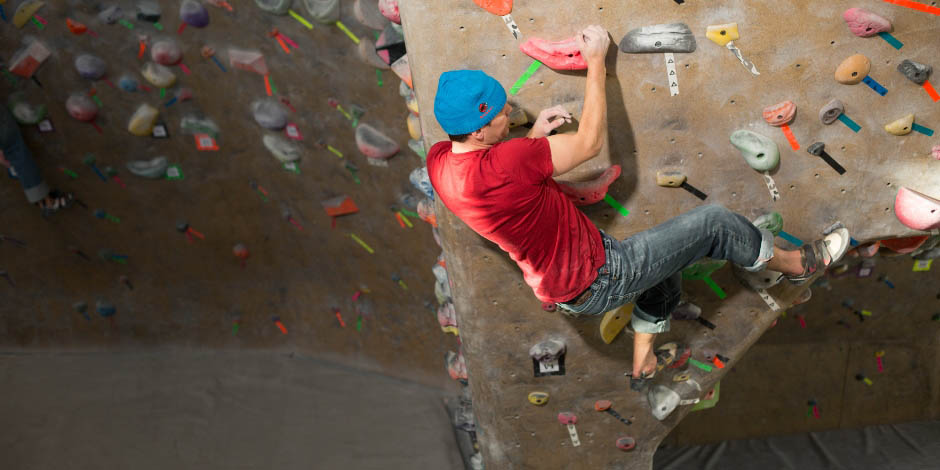Rock your workouts with indoor rock climbing.
Tired of the same old exercise routine that takes you nowhere? Here’s a whole new exercise that will push you up to the next level—literally.
Research backs up what you instinctively know: When it comes to exercise motivation, variety is key. If you’ve plateaued in your strength-training routine or you’re stuck in a yoga rut, consider climbing—quite literally—your way out of it at a local climbing gym or indoor rock wall.For fitness benefits, rock climbing rivals many traditional gym workouts, including yoga. “It has a nice combination of strength, power and also flexibility, as you stretch to reach a handhold or foothold,” says Mary-Laurence Bevington, managing director of Movement Climbing + Fitness in Boulder. Here’s how climbing can transform your body and energize your approach to fitness.
Get ripped
As you might expect, climbing tones your upper body—shoulders, upper back, biceps and core—but if you climb correctly, your legs are the real heavy hitters. “It seems like a contradiction, but in order to move up the wall efficiently, you need to push down with your legs rather than just pull up with your upper body,” Bevington explains.
Climbing also targets smaller, lower-profile muscle groups, such as those in your hands, forearms and feet. “Sometimes I’ll have new climbers say, ‘I didn’t even know I had a muscle there,’” says Tricia Fehr Carver, manager of Rock’n and Jam’n climbing gym in Centennial. That means newcomers should ease into the sport while their bodies adjust, doing just a few routes in the first several visits. “It can take 10 weeks for your hands to gain strength relative to your core muscles,” Bevington says.
To stay balanced, climbers should supplement workouts with exercises that target muscles on the front of the body—chest, triceps, quads—which don’t see as much action at the climbing gym, Carver says. Three days a week, do a few sets of push-ups, dips and squats to prevent muscle imbalances. Climbers also tend to spend a lot of time with their shoulders rounded forward toward the wall; counteract that motion by extending your arms out from your sides, expanding your chest and pulling your shoulder blades together. Hold for 10 seconds, release and repeat four times.
Rev Your Heart
Climbing won’t provide the same sustained cardio benefits as activities such as running or cycling, but it can get your heart pumping with short anaerobic power bursts as you propel yourself from one position to another. Experienced climbers can employ their aerobic energy system as well by doing quick laps on long routes, but novices may want to mix in cardio workouts two to three times per week.
Engage Your Mind
Creativity, awareness and concentration are not just possible side benefits of climbing—they’re essentials. “You have to have focus to be successful,” Carver says. Climbing can also help athletes overcome psychological barriers like fear of heights or trust issues. “You learn to trust the equipment and the people belaying you,” Carver adds. “It’s mentally and emotionally engaging.” As an added bonus, climbing tends to be a social sport, with friends, coworkers, family members or even other gym members often climbing together to belay one another and offer tips and encouragement.
Jump In
A base fitness level makes climbing easier, but the sport is accessible to almost anyone. “If you can climb a ladder, you can climb a wall,” Carver says. Both Carver and Bevington recommend an introductory lesson that covers basic techniques, an equipment and gym overview, and safety precautions. You will likely improve your fitness and your technique in just a few lessons, Carver says. “It’s easy to see progress as you climb harder and harder routes, and conquer routes that you couldn’t do even a week or two before.”
High Gear
Most climbing gyms offer introductory lessons that include rental equipment. Once you’re hooked, you’ll want to purchase your own. You’ll need:
Harness: Supports your body as you climb.
Approximate cost: $50–$150
Belay Hardware: Attaches your harness to the ropes.
Approximate cost: $10–$100
Climbing Shoes: Sleek, tightfitting shoes that allow your feet to grip the holds on the wall.
Approximate cost: $70–$170




